What to visit
Church of the Assumption of the Virgin Mary and St. Wenceslas
The church is a one-nave pseudogothic brick building from the 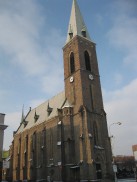 years 1894-1895. Its presbytary is uncommonly facing north.The church tower is 63 m tall. Originally Kralupy belonged to the parish of Minice. Building the church was a requirement for Kralupy to gain a town status, but the former village couldn´t afford it. The construction became possible thanks to a generous donation by a Prague provost Dr. Eduard Tersch. He covered 2/3 of the cost, donated some equipment for the church - for example an organ (which has 2 manuals and 16 registers, author Em. Š. Petr, Praha). Dr. Tersch preached at the consecration of the church on October 27th 1895. Three years later, he passed away and was buried in the tomb in front of the main altar. The interior equipment of the church is also neogothic, coming from the end of the 19th century. The current bells on the church tower have been in use since 1991 (they were purchased by the company Kaučuk) and they are actually the third ones during the church´s history – the previous bells were confiscated during the first and second World Wars. The Kralupy church and its bells have appeared in some poems by J. Seifert. On the outside of the church, there are two memorial plaques: for the victims of the air raid in 1945 and to mark the water level during the floods in 2002.
years 1894-1895. Its presbytary is uncommonly facing north.The church tower is 63 m tall. Originally Kralupy belonged to the parish of Minice. Building the church was a requirement for Kralupy to gain a town status, but the former village couldn´t afford it. The construction became possible thanks to a generous donation by a Prague provost Dr. Eduard Tersch. He covered 2/3 of the cost, donated some equipment for the church - for example an organ (which has 2 manuals and 16 registers, author Em. Š. Petr, Praha). Dr. Tersch preached at the consecration of the church on October 27th 1895. Three years later, he passed away and was buried in the tomb in front of the main altar. The interior equipment of the church is also neogothic, coming from the end of the 19th century. The current bells on the church tower have been in use since 1991 (they were purchased by the company Kaučuk) and they are actually the third ones during the church´s history – the previous bells were confiscated during the first and second World Wars. The Kralupy church and its bells have appeared in some poems by J. Seifert. On the outside of the church, there are two memorial plaques: for the victims of the air raid in 1945 and to mark the water level during the floods in 2002.
The Bridge of T.G. Masaryk
Until 1928, both Vltava shores were connected only by a ferry. The bri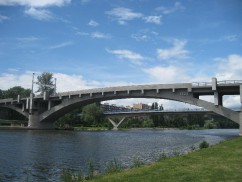 dge was built after longstanding efforts of the town in the years 1926 - 1928. This reinforced concrete bridge spans Vltava with one arch and the adjacent quays with the other two arches. The building is very unique for its time thanks to the 80 m span of the middle arch (the columns couldn´t be placed in the river). The project was developed by J. Farský and J. Kroha. During the period of the First Republic, people had to pay a toll for crossing the bridge (the money was used for the maintenance of the bridge). The toll collector's booth has been preserved on the Kralupy side of the bridge. Near the toll-both on both sides of the bridge, there are two granite memorial plaques: one plaque with a description of the bridge construction and embossed emblem of the city, the other plaque with the relief of T. G. Masaryk, after whom the bridge was named.
dge was built after longstanding efforts of the town in the years 1926 - 1928. This reinforced concrete bridge spans Vltava with one arch and the adjacent quays with the other two arches. The building is very unique for its time thanks to the 80 m span of the middle arch (the columns couldn´t be placed in the river). The project was developed by J. Farský and J. Kroha. During the period of the First Republic, people had to pay a toll for crossing the bridge (the money was used for the maintenance of the bridge). The toll collector's booth has been preserved on the Kralupy side of the bridge. Near the toll-both on both sides of the bridge, there are two granite memorial plaques: one plaque with a description of the bridge construction and embossed emblem of the city, the other plaque with the relief of T. G. Masaryk, after whom the bridge was named.
Bomb bunker on Hostibejk
After the 2nd World War begun, the Germans built an air defense site, 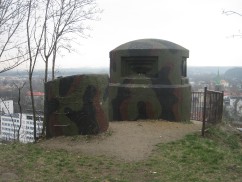 consisting of a concrete observatory (bunker), cannon platforms, and an ammunition depot. It was intended for anti-aircraft defense of the Kralupy railway junction and of the refinery which was situated nearby (in the compound today called after the former factory “Barvy-laky”). In 1941, the weaponry was sent to the front and until the end of the war, Kralupy didn't have any anti-air defense. From around the bunker you can enjoy a nice view of the town centre (the inside of the bunker is not accessible to the public).
consisting of a concrete observatory (bunker), cannon platforms, and an ammunition depot. It was intended for anti-aircraft defense of the Kralupy railway junction and of the refinery which was situated nearby (in the compound today called after the former factory “Barvy-laky”). In 1941, the weaponry was sent to the front and until the end of the war, Kralupy didn't have any anti-air defense. From around the bunker you can enjoy a nice view of the town centre (the inside of the bunker is not accessible to the public).
Monument of J. Seifert on the Seifert Square 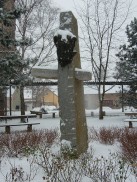
The monument is placed in the park opposite the community centre Vltava. It was created in 1997 by the sculptor Stanislav Hanzík. It is a partially processed granite obelisk with a stylized face of the poet.
The cross and a replica of a small chapel with a belfry in the street Ve Starém Lobečku
The stone cross stands behind the fence of the school playground in the street Ve Starém Lobečku. It was built in 1869. Next to the cross, there used to be a chapel with a belfry, which was demolished in 1967 along with other buildings before the construction of the elementary school. During 2012, a replica was re-built on the same place. In the lower part of the cross pedestal is a plate marking the water level during the flood in 2002.
Statue of Our Lady of Sorrows - Marian column 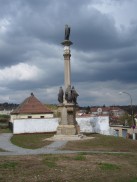
A valuable baroque sandstone sculpture from the first half of the 18th century, probably by M. Brokoff. It consists of the statue of the Virgin Mary on the top of the column and the statues of st. Tereza, st. Anne and st. Františka. Originally, the sculpture stood in the middle of the crossroad of the streets 28. října and Velvarská, but in 1988, it was removed due to growing traffic and car accidents. From 2003 the sculpture was being gradually restored and in 2009 it came back, only about 20m away from its original place, off the crossroads.
The church of saint James, son of Zebedee
This church is the oldest monument in the city – it was first mentioned in the 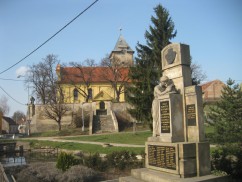 half of the 14th century. It used to be the parish church for Minice, Kralupy, Lobeč and Debrno. It has one nave with a tower and sacristy, it was rebuilt several times, the last reconstruction being in Neo-Renaissance style. During the last restoration in the years 1994-1995, a walled up window in the presbytary was uncovered. Before a new cemetery was built above Minice, there used to be a cemetery around the church. J. Seifert's parents had their wedding in this church.
half of the 14th century. It used to be the parish church for Minice, Kralupy, Lobeč and Debrno. It has one nave with a tower and sacristy, it was rebuilt several times, the last reconstruction being in Neo-Renaissance style. During the last restoration in the years 1994-1995, a walled up window in the presbytary was uncovered. Before a new cemetery was built above Minice, there used to be a cemetery around the church. J. Seifert's parents had their wedding in this church.
Church of St. John the Baptist
The existence of a church in Zeměchy is documented as early as in 1352, 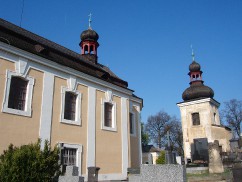 however originally it stood in the village (approximately where the bus stop is nowadays). The previous buildings were destroyed in the Hussite wars and in The Thirty Years' War. The current church was built in 1723 on a small hill above the village green and is surrounded by a cemetry. It is a baroque church beside which is standing a separate bell tower with onion-shaped dome. The nave (with no tower) has a shingle roof and a belfry. Around the church there is a cemetery. A wooden polychrome relief of "The Last Supper" was placed in the church for almost 150 years. Originally, it came from the Bethlehem Chapel in Prague. Since 1918 this rare relic has been kept in the National Museum in Prague.
however originally it stood in the village (approximately where the bus stop is nowadays). The previous buildings were destroyed in the Hussite wars and in The Thirty Years' War. The current church was built in 1723 on a small hill above the village green and is surrounded by a cemetry. It is a baroque church beside which is standing a separate bell tower with onion-shaped dome. The nave (with no tower) has a shingle roof and a belfry. Around the church there is a cemetery. A wooden polychrome relief of "The Last Supper" was placed in the church for almost 150 years. Originally, it came from the Bethlehem Chapel in Prague. Since 1918 this rare relic has been kept in the National Museum in Prague.
The Municipal Museum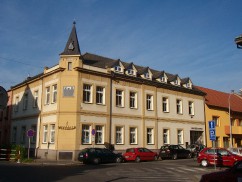
Vrchlického 590
opening hours: Tu-We, Fri: 9-12, 13-16
Th- 9-12, 13-19
Sa- 13-17
Contacts:
tel.: 315 723 035,
email: Info@muzeumkralupy.cz,
web: muzeumkralupy.cz
The municipal museum comprises the department of archaeology with objects from the ancient fortified settlement of Minice, the exposition on the town´s history, Jaroslav Seifert and Georges Kars memorial hall and a small collection of stone monuments with a prehistoric workshop. Apart from the permanent expositions the museum also offers various temporary exhibitions.


